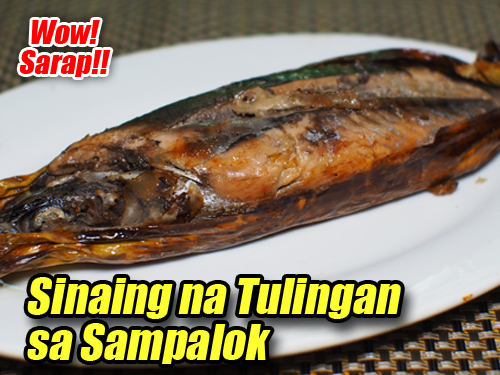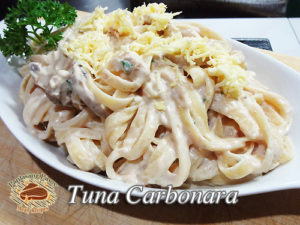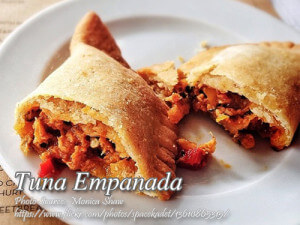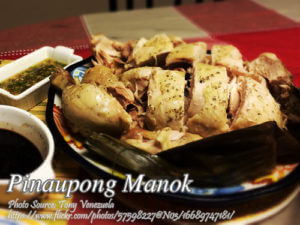Sinaing na tulingan is a tasty and popular Filipino fish delicacy made of skipjack tuna that is easy to prepare and to cook. The way of cooking this dish is usually cooked slow in an earthen pot or clay pot in the old days until the fish is very soft together with the fish meat and fish bones. It is like eating a canned fish if you ask my opinion because of very soft meat and fish bones.
You serve it right after cooking the fish in the pot but there is extra step so you can it more delectable and appetizing. Before serving, fry the fish still wrapped in the banana leaf until brown. Then serve it with a dipping sauce of kalamansi and patis. One more thing, to be safe, remove the tail gland by twisting the tail and pulling it. These glands contains toxins that can make you itch after eating.
Unlocking the Flavors of Sinaing na Tulingan sa Sampalok
Sinaing na tulingan, a beloved Filipino fish delicacy, is a dish that stands out for its delectable taste and straightforward preparation. Traditionally cooked in an earthen pot, this slow-cooked skipjack tuna leaves you with tender fish meat and flavorful broth. In this guide, we’ll delve into the step-by-step process of making Sinaing na Tulingan sa Sampalok, ensuring you unlock its full potential.
Preparing the Tulingan
Begin by prepping the main ingredient, the skipjack tuna. Remove the gills and innards of the tulingan, making sure to clean the fish thoroughly. A shallow cut on both sides aids in the even absorption of flavors. Washing the fish in running water and allowing it to drain ensures a clean and dry foundation for the next steps.
Safety Tip
Before starting the preparation, be sure to remove the tail gland by twisting and pulling it. The tail glands contains toxins that will make you itch after eating the fish. The tail gland of the tulingan, is a small, dark-colored organ found near the tail of the fish. This gland contains toxins that can cause discomfort if ingested. It’s crucial to remove the tail gland before cooking and consuming the tulingan to ensure the safety and enjoyment of the dish.
Infusing Flavor with Salt and Pepper
To enhance the taste, take the palm of your hand and gently press the tuna. Rub a mixture of salt and pepper onto the fish, ensuring each side gets a generous coating. This simple yet effective step lays the foundation for a well-seasoned and savory sinaing na tulingan.
Creating Flavorful Bundles with Banana Leaves
Banana leaves play a crucial role in imparting a unique aroma and flavor to the dish. Lay a piece of banana leaf sheet on a clean surface and position the tulingan in the center. Enhance the richness by placing slices of fat on the sides of the fish. Wrap the fish securely with banana leaves, creating bundles of flavor that will infuse into the tuna during the cooking process.
Layering the Pot for Maximum Taste
Prepare your cooking vessel, be it an earthen pot or clay pot. Lay two sheets of banana leaf at the bottom and add the pork fat, ensuring an even distribution. Layer the pot with ginger, garlic, and sampalok fruits, creating a flavorful bed for the tulingan. Place the wrapped tulingan on top and sprinkle some more salt and pepper for an added burst of taste. Pour water into the pot, enough to cover the fishes, and you’re ready for the slow-cooking magic to begin.
Slow-cooking Perfection
Place the pot on the stove and let the magic unfold. Allow the sinaing na tulingan to simmer for an hour or until the fish reaches the desired tenderness, and the liquid has reduced to perfection. The slow cooking process ensures that every bite is infused with the rich flavors of the ingredients, creating a mouthwatering experience.
Taking it Up a Notch: The Finishing Touch
For an extra layer of appetizing appeal, consider frying the sinaing na tulingan before serving. Seal the wrapped tulingan by tying both ends or using a thin strip of banana leaf. Heat cooking oil and fry the fish until it achieves a tempting golden brown. This step not only adds a delightful crunch but also intensifies the flavors, making your sinaing na tulingan a visual and culinary delight.
Serve your sinaing na tulingan as a viand with a side of steamed rice and a dipping sauce comprising kalamansi juice and patis. The citrusy and savory combination complements the dish, elevating the overall dining experience.
Wrapping-Up
Sinaing na Tulingan sa Sampalok is more than just a dish – it’s a culinary journey. By following these steps, you unlock the full potential of this Filipino favorite, making every bite a celebration of flavors and traditions. Enjoy the process, savor the results, and share the joy of Sinaing na Tulingan with your loved ones.
Sinaing na Tulingan sa Sampalok
Ingredients
- 1 kilo medium sized tulingan skipjack tuna
- 1/4 kilo pork fat
- 1/4 kilo tamarind fruits or kamias fruits
- 2 Tbsp. minced garlic
- 2 inch size ginger sliced
- equal amount of sea salt and black pepper
- 6 sheets banana leaves
- cooking oil for frying
Instructions
How to Cook Sinaing na Tulingan sa Sampalok
- Remove the gills and innards of the tulingan (skipjack tuna). Make a shallow cut on both sides of the fish.
- Make sure to remove the tail gland by twisting the tail and pulling it. The tail gland contains toxins that will make you itch after eating.
- Wash in running water and drain in a colander to dry. Press the tuna with the palm of your hand and rub with salt-pepper mixture.
- Lay a piece of banana leaf sheet in a clean surface and put the tulingan in the center.
- Put pieces of the sliced fat on the sides of the fish and wrap the fish with banana leaf. Do the same procedure on the rest of the tulingan.
- In an empty pot, lay two sheets of banana leaf on the bottom. Put the pork fat first on the banana leaf. Distribute it on the bottom of the pot.
- Add ginger, garlic and sampalok fruits layer by layer. Then put the wrapped tulingan in the pot.
- Sprinkle some salt-pepper mixture on top of the tulingan. Pour water just enough to cover the fishes.
- Put on the stove and cook for an hour of until the tulingan are tender and the liquid is reduced.
- You can also fry it before serving to make it more appetizing. Seal the wrapped tulingan by tying both ends with a piece of twine or make a thin strip of the banana leaf.
- Heat cooking oil and fry the fish just like frying a pinaputok na tilapia or pinaputok na bangus.
- Serve as a viand with cooked rice and some dipping sauce consisting of kalamansi juice and patis. Enjoy!
Video
Notes
Cooking Tips of Sinaing na Tulingan sa Sampalok
- Banana Leaf Magic: Enhance Flavor and Tenderness To impart a unique aroma and tenderness to your Sinaing na Tulingan, use banana leaves. After rubbing the tulingan with salt and pepper, wrap it securely in banana leaves. This method not only infuses the dish with a subtle, earthy flavor but also keeps the fish moist during the slow-cooking process. The leaves act as a natural wrapper, allowing the flavors to meld and intensify, resulting in a more delicious and aromatic dish.
- Layering for Depth: Infuse Aromatics into Every Bite Elevate the taste of your sinaing na tulingan by layering the pot with aromatic ingredients. Start with two sheets of banana leaf at the bottom, followed by a distribution of pork fat. Layer ginger, garlic, and sampalok fruits strategically, creating a flavorful bed for the tulingan. As the dish simmers, these layers infuse the fish with a rich blend of spices, creating a depth of flavor that will leave your taste buds delighted.
- Tail Gland Caution: Prioritize Safety in Preparation Ensure a safe dining experience by removing the tail gland before cooking. This small organ is located near the tail and contains toxins that can cause discomfort if consumed. To eliminate this risk, twist and pull the tail to remove the gland. Prioritizing this step guarantees that your sinaing na tulingan not only tastes delightful but is also safe for consumption. Safety in preparation ensures a worry-free and enjoyable dining experience for you and your loved ones.
Nutrition Notes:
Calorie and other nutrition information is derived from HappyFolks.Com recipe nutrition calculator. The percent daily value (%DV) is based on a daily 2,000 calorie diet.Nutrition Facts:
Amount per Serving:283g, Calories:820kcal, From fat:555, Total fat:62.4g, Saturated Fat:33.1g, Trans Fat:0g, Cholesterol:120mg, Sodium: 139 Total Carbohydrate: 28g, Dietary Fiber: 2g, Sugars: 17g, Protein: 39g, Vitamin A: 4%, Vitamin C: 38%, Calcium: 9%, Iron: 19%





